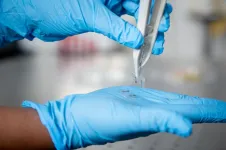(Press-News.org) Palmer Amaranth is a high-impact agronomic weed species that has cost the United States agriculture industry billions of dollars since its discovery outside of its native range in the southwestern U.S. and northwestern Mexico. Over the last 20 years, it has moved further north, and now poses a major threat to corn, soybean, and cotton growers across the south and Midwest regions of the United States.
It is not legal to sell any kind of seed in Minnesota if the seed lot contains Palmer Amaranth. The problem is this particular invasive species--which has shown potential to wipe out up to 91% of corn yields, 68% of soybean yields, and 54% of cotton yields-- is difficult to visibly distinguish from other pigweed species, making identification reliant upon genetic testing.
In a recent study published in Pest Management Science, researchers from the University of Minnesota's Minnesota Invasive Terrestrial Plants and Pests Center (MITPPC) and Colorado State University have developed a new test for identifying Palmer Amaranth that is more robust, easier to use, and -- most importantly -- has shown 99.9% accuracy.
Due to rapid spread of herbicide resistance traits in Palmer populations, the prevention of Palmer establishment is more important than ever. Researchers hope to make the new test technology commercially available to agronomic professionals across the United States by the end of 2021, which can be applied to both individual samples and bulk seed mixes.
"Development of tools and weed seed regulations play important roles, but ultimately it all comes back to the growers," said lead author Anthony Brusa, a postdoctoral associate in the College of Food, Agricultural and Natural Resource Sciences. "Prevention of Palmer is a team effort. So far, every initial sighting of Palmer in Minnesota was from a grower, and control efforts wouldn't be possible without their help."
To develop the test, researchers collected samples of Palmer Amaranth and related species from across the United States, as well as Mexico, South America and Africa. They then performed genomic sequencing on these samples and searched for specific genetic differences between species. The targets identified were then used to design a set of three genetic markers for the identification of Palmer DNA against the DNA of related pigweed species. Finally, those tests were validated for performance against the most robust testing panel assembled to date.
"We hope that this will be the first of many molecular diagnostics developed for weed seed testing," said co-author Eric Patterson, an assistant professor and weed geneticist at Michigan State University. "The gates are open for developing tests for herbicide resistance, seed contamination, and seed bank diversity."
Accuracy for these markers ranged from 99.7%-99.9%, with only one-to-three errors against a panel of 1,250 samples. Bulk seed testing showed reliable detection of Palmer at a level of one Palmer seed in a mix of 200 pigweed seeds.
"We believe this has the potential to help prevent Palmer seed from being introduced as a contaminant in pollinator seed mixes, bird seed, and other seed lots sold from areas where Palmer is currently a problem, into areas like Minnesota," said co-author Todd Gaines, an associate professor of molecular weed science at Colorado State University. "We also see great potential for this to be used to help protect corn and soybean exports by verifying the absence of Palmer in grain sold to countries that won't accept Palmer-contaminated products."
In the immediate future, the research team continues to investigate novel approaches for Palmer control, and are currently investigating the potential use of genomic testing to identify Palmer presence in soil seed banks.
"The development of these new markers and their commercialization will provide new options to seed companies labeling seed for sale in Minnesota as well as other industries that may be at risk for introducing Palmer Amaranth via screenings, hay, equipment, or feed," said Denise Thiede, section manager for seed, noxious weed, hemp, and biotechnology at the Minnesota Department of Agriculture.
INFORMATION:
The research was funded by the Minnesota Invasive Terrestrial Plants & Pests Center through the Minnesota Environment and Natural Resources Trust Fund, and collaborators included University of Minnesota Extension, Colorado State University, Michigan State University, and the Minnesota Department of Agriculture.
Scientists create stable nanosheets containing boron and hydrogen atoms with potential applications in nanoelectronics and quantum information technology.
What's thinner than thin? One answer is two-dimensional materials -- exotic materials of science with length and width but only one or two atoms in thickness. They offer the possibility of unprecedented boosts in device performance for electronic devices, solar cells, batteries and medical equipment.
In collaboration with Northwestern University and the University of Florida, scientists from the U.S. Department of Energy's (DOE) Argonne National Laboratory report in Science ...
How do we become a complex, integrated multicellular organism from a single cell?
While developmental biologists have long researched this fundamental question, Stanford University biologist and HHMI investigator Dominique Bergmann's recent work on the plant Arabidopsis thaliana has uncovered surprising answers.
In a new study, published April 5 in Developmental Cell, led by Bergmann and postdoctoral scholar Camila Lopez-Anido, researchers used single-cell RNA sequencing technologies to track genetic activity in nearly 20,000 cells as they formed the surface and inner parts of an Arabidopsis leaf. Through this highly detailed technique, the researchers captured ...
PHILADELPHIA - A team led by scientists at the Perelman School of Medicine at the University of Pennsylvania has illuminated the functions of mysterious structures in cells called "nuclear speckles," showing that they can work in partnership with a key protein to enhance the activities of specific sets of genes.
The discovery, which will be published on April 5 in Molecular Cell, is an advance in basic cell biology; the key protein it identifies as a working partner of speckles is best known as major tumor-suppressor protein, p53. This avenue of research may also lead to a better future understanding of cancers, and possibly better cancer treatments.
"This study shows that nuclear speckles work as major regulators of gene expression, and suggests that ...
UNIVERSITY PARK, Pa. -- Approximately 40,000 children in the United States may have lost a parent to COVID-19 since February 2020, according to a statistical model created by a team of researchers. The researchers anticipate that without immediate interventions, the trauma from losing a parent could cast a shadow of mental health and economic problems well into the future for this vulnerable population.
In the researchers' model, for approximately every 13th COVID-related death, a child loses one parent. Children who lose a parent are at higher risk of a range ...
CHICAGO - A new study shows that youth arrested as juveniles with psychiatric disorders that remain untreated, struggle with mental health and successful outcomes well beyond adolescence.
Research from Northwestern Medicine shows nearly two-thirds of males and more than one-third of females with one or more existing psychiatric disorders when they entered detention, still had a disorder 15 years later.
The findings are significant because mental health struggles add to the existing racial, ethnic and economic disparities as well as academic challenges from missed school, making a successful transition to adulthood harder to attain.
"Kids get into trouble during adolescence.Those from wealthier families also use drugs and get into fights. But these situations are most often ...
What The Study Did: Researchers estimated and projected the number of children in the United States affected by the death of a parent from COVID-19.
Authors: Rachel Kidman, Ph.D., of Stony Brook University in Stony Brook, New York, is the corresponding author.
To access the embargoed study: Visit our For The Media website at this link https://media.jamanetwork.com/
(doi:10.1001/jamapediatrics.2021.0161)
Editor's Note: The article includes conflict of interest disclosures. Please see the article for additional information, including other authors, author contributions and affiliations, conflict of interest and financial disclosures, and funding and support.
INFORMATION:
Media advisory: The full study is linked to this news release.
Embed this link to provide your readers ...
CLAREMONT, CA - Keck Graduate Institute (KGI) Assistant Professor and University of California, Berkeley Visiting Scientist Dr. Kiana Aran first introduced the CRISPR-Chip technology in 2019. Now just two years later, she has expanded on its application to develop CRISPR-SNP-Chip, which enables detection of single point mutations without amplification in Sickle Cell Disease and Amyotrophic lateral sclerosis (ALS).
"The field of CRISPR-based diagnostics is rapidly evolving due to CRISPR programmability and ease of use," Aran says. "However, the majority of CRISPR-based diagnostics platforms are still relying on target amplifications or optical detections. The reprogrammability of CRISPR combined with optics-free highly scalable graphene transistors will allow us to bring the ...
A new study, out this week, could pave the way to revolutionary, transparent electronics.
Such see-through devices could potentially be integrated in glass, in flexible displays and in smart contact lenses, bringing to life futuristic devices that seem like the product of science fiction.
For several decades, researchers have sought a new class of electronics based on semiconducting oxides, whose optical transparency could enable these fully-transparent electronics.
Oxide-based devices could also find use in power electronics and communication technology, reducing the carbon footprint of our utility networks.
A RMIT-led team has now introduced ultrathin beta-tellurite to the two-dimensional (2D) semiconducting material family, providing ...
Irvine, Calif. -- In 2019, the National Weather Service in Alaska reported spotting the first-known lightning strikes within 300 miles of the North Pole. Lightning strikes are almost unheard of above the Arctic Circle, but scientists led by researchers at the University of California, Irvine have published new research in the journal Nature Climate Change detailing how Arctic lightning strikes stand to increase by about 100 percent over northern lands by the end of the century as the climate continues warming.
"We projected how lightning in high-latitude boreal forests and Arctic ...
An interdisciplinary team led by KU Leuven and Stanford has identified 76 overlapping genetic locations that shape both our face and our brain. What the researchers didn't find is evidence that this genetic overlap also predicts someone's behavioural-cognitive traits or risk of conditions such as Alzheimer's disease. This means that the findings help to debunk several persistent pseudoscientific claims about what our face reveals about us.
There were already indications of a genetic link between the shape of our face and that of our brain, says Professor Peter Claes from the Laboratory for Imaging Genetics at KU Leuven, who is the joint senior author of the study with Professor Joanna Wysocka from the ...


